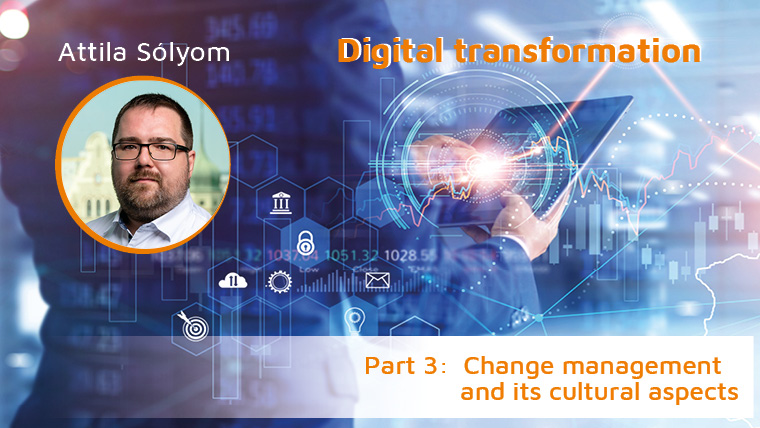
25-05-2023
Hungary
Outsourcing
Digitalization, Digital transformation, Automation, Change management, Organisation culture
Author: Attila Sólyom, Digital Transformation Director
Process Solutions
Let’s begin with change management, which is a crucial component of digital transformation. It helps organizations prepare for and manage the changes that come with adapting new technology. Effective change management involves:
- Create a vision for the future state of the organization
- Communicate that vision to all stakeholders (employees, managers, shareholders and even customers)
- Engage employees and provide them with the training and support they need
One of the more significant challenges is to ensure that the organization can sustain the changes over the long term, generating value though leveraging digital technology. For example, a state-of-the-art reporting system is of far less value, if all internal decisions continue to be supported with hastily prepared, cross-linked Excel files. Continued value generation can be addressed by establishing metrics, feedback, and control to stay on track and in line with all stakeholder’s expectations.
Change management and culture
Company culture is how we do what we do in the workplace. It’s the sum of formal and informal systems and behaviours and values, all of which create an experience for our employees and customers. [2]
Let’s backtrack to the question of cultural constrains, or rather, challenges. In accounting and finance, digital transformation most often means an overhaul of well-known, long-established practices by adopting new tools and technologies. Accounting is on the more risk-averse side of the spectrum, especially if it is rendered as a service – there’s of course, more flexibility in management accounting, while statutory compliance is de facto rigid. We certainly don’t want to risk a hefty fine from the tax authority because we’re experimenting.
Change on the other hand inherently possesses some risk. It is safe to assume, that transforming accounting services will be met with more scepticism than the display of moderate hopefulness about eliminating vast amounts of manual and repetitive tasks. As such, our priority pursuing successful and sustainable digitalization must be the work culture and people. Budget, available technology, development and implementation all play a significant role, but in our experience, in our market, the pivotal point is the attitude and behaviour of people in the face of changes.
The human side of digitalization
While the soft side of digital transformation might often be overlooked, we fortunately have multiple methods to engage with different levels of an organization. Humans are excellent in adapting to change, but there is a limit to this. Generation Z seemingly has a lower tolerance than one would expect – this could very well be because they expect change to come from dialogue [3], rather than command – so, we may fail to provide enough support and two-way communication opportunities. Taking this a step further, an organization must be able to assess and know its people, their general attitude and acceptance for change. This can be done though questionnaires, focus groups, wider engagement surveys or by providing channels of engagement opportunities like and idea box and assessing its metrics.
Doing so enables us to prioritize initiatives that can be executed in our current environment and drive us on the path of executing the digitalization strategy, one step at a time. Carefully selecting what can and cannot be accepted by people of an organization at a given time, can be the difference between a successful or lacking digital transformation. This much detail is sufficient for this article; we will explore the human side of technology in an upcoming issue further.
Mitigating cultural resistance
An important note for further consideration, is that top-down and bottom-up approaches must be used simultaneously. We don’t believe powering through changes in the hierarchy can work on its own, as any significant change needs widespread adaptation. Similarly, a pure bottom-up approach is doomed if leadership refuses to adapt and support colleagues driving initiatives. Balancing this effectively is not an easy undertaking – we can start by analysing engagement metrics, identifying blockages and pioneers as well as looking at lessons learned from previous endeavours. The good news is, this is similar to the attitude and engagement assessments discussed before, so the same tools can be used to achieve multiple objectives.
Let’s see 5 of the most important methods we can utilize to mitigate the risk of cultural resistance, building up from smaller parts (executable actions) to the more holistic approach of behavioural and ultimately, cultural change:
1 Engage employees in the process, demonstrate the benefits and reassure risk mitigation
End-user involvement is not only mandatory in most project management methodologies (take for instance PRINCE2 [4]), but also an excellent tool to create early adaptors and agents of change in every level, as well as helping the digitalization team understand core business problems and addressing them properly.
Perhaps a wider involvement is required in more risk-averse environments to ensure benefits are understood and provide ample reassurance about plans to handle the risks involved. Note that involvement is not synonymous with status updates provided – it means active engagement though two-way communications and ensuring all parties understand and ideally, accept the “why” in any given phase of a project. This means meetings, workshops, brainstorming and shared signoffs for example.
Benefits don’t necessarily mean direct cost reduction or time saved either – consider for example the fact that an employee can work on more meaningful tasks, which can mitigate burnout; or though eliminating robot-like tasks one can focus on what humans are great at, intuition and judgement – this means a junior accountant can become an established professional much faster due to being exposed to value-added tasks sooner and more often.
In other words, if we can genuinely and continuously demonstrate that the future benefits of changes will unquestionably exceed the extent of today’s pressures, and moreover, will provide a better working environment, quicker career route for employees at all levels, we will continuously have our peoples’ high-level engagement.
The downside of wider engagement is of course, resource requirements, as well as, generally speaking, the more people are involved, the slower a project will go because of extensive stakeholder management, exponential rise in interactions and simply, more interests to align. In our view however, the benefits of more employee engagement certainly outweigh the costs; the challenge is finding the right balance.
2 Leadership must model the behaviours they want to see in their employees
While point 1) addresses the most important bottom-up aspect, in close second must come the top-down, aka. leadership engagement and support. An interesting challenge for any significant change, digitalization included, is to find active leadership support and leverage that support during all phases of a project, from inception, through implementation to ultimately, long-term value generation. Our most important point here is that key stakeholders must not only support, but actively engage in behaviour modelling the desired changes towards the employees. Clear, consistent, and transparent two-way communication as well as early adoption helps most.
A successful digital transformation initiative must support the leaders in its organization to be able to engage with their people meaningfully in change management practices themselves. There are multiple ways to achieve this:
- workshops involving multiple stakeholders
- regular reporting with the opportunity to reflect
- specific trainings
- open-hours
- early demos and trials.
Leadership must understand employee needs and recognize frustrations; and support adapting behaviour which embraces and actively engages with, and from time to time, challenges change initiatives to the benefit of the whole company.
3 Fostering an open and transparent communication environment
While it may even seem trite, this is a rather significant challenge in a dominantly risk-averse environment, such as accounting service provision. As mentioned before, all changes possess inherent risk, and in the event of an actual occurrence, employees must feel confident, secure, and supported. Hence, communication about realistic expectations and risk mitigation is extremely important. In such a rapidly changing business environment, this is rather challenging. By ensuring employee and leadership engagement during the change process, we believe this becomes less of an issue, as benefits, risk mitigations and expectations are trickled down in the organization, rather than being poured down on it at a selected go-live date. We cannot emphasize enough the importance of two-way communications instead of presentations and statements.
4 Encourage employees to take ownership of their own development and learning
Any business may consider this point an important aspect of their long-term success. One must recognize, define, and execute actions to ensure its employees are able to adapt to changing environment, regardless of whether it is driven by internal or external factors. In our previous article [5] we highlighted agility as one of the 5 key goals for digital transformation. Supporting continuous learning and development is a more general objective of course, than the prior ones mentioned in this article – however, if an organization fosters self-training and supports it with company-wide programs – such as our popular internal e-learning system -, it helps greatly with managing change.
5 Create a culture that values and embraces change
Perhaps the most general and longest-term point of all – creating an organisational culture that values and embraces change. Any organization that wants to create sustainable shareholder value and growth must take reasonable risks. This of course, is influenced by many factors, such as the market one is working on, the closer and wider environment, the risk-aversion or risk-seeking of different stakeholders, etc. Not taking enough risk means competition will eventually overtake. Being reckless on the other hand, can quickly eliminate young or small businesses from the competition altogether, or impose severe hardship in an otherwise stable environment.
The challenge here is the right balance again. All the above points help transitioning towards a desired level of risk-taking – change embracing – culture.
Conclusion
When it comes to digital transformation, the cultural challenges of implementing and using complex digital systems must not be overlooked. One must create a clear vision for the future state of the organization, communicate that vision to all stakeholders and engage employees and provide them with the training and support they need. One of the main challenges is ensuring that the organization can continue generating value through digital technology in the long run. To achieve this, it’s essential to establish metrics, feedback, and control to stay on track with all stakeholders’ expectations. Accounting and finance are typically risk-averse, so digital transformation can be met with scepticism. Therefore, successful, and sustainable digitalization relies on work culture and people. To mitigate cultural resistance, engage employees, demonstrate benefits, reassure risk mitigation, involve users in project management, and balance top-down and bottom-up approaches.
Benefits of digital transformation aren’t just cost reduction and time savings. A successful transformation should result in improved productivity, increased accuracy, better decision-making, and overall business growth, and even better employee experience and customer satisfaction.
As feedback, please provide us your experience with new solutions in your organization! OCR nowadays is rather well spread – pioneer technologies, such as AI assisted communications or even, bookkeeping is less so – for now. What technologies does your organization prefer, and how did it affect the company culture? Let us know at info-psgroup@ps-bpo.com!
A cikk olvasható magyarul is a PS HU karrieroldalán >>
Our former posts about digital transformation:
Part 2 – 5 Key goals for digital transformation in professional business services
Part 1 – Digitalization – The engine of economic growth in the 21st century
Sources:
[1] whatfix.com/blog/digital-transformation-challenges/
[2] www.greatplacetowork.com/resources/blog/company-culture-meaning-benefits-and-strategies
[4] prince2.wiki/roles/senior-user/
[5] ps-bpo.com/blog/5-key-goals-for-digital-transformation-in-professional-business-services/
Review and read our previous blog posts here.
Follow us on LinkedIn!
????

